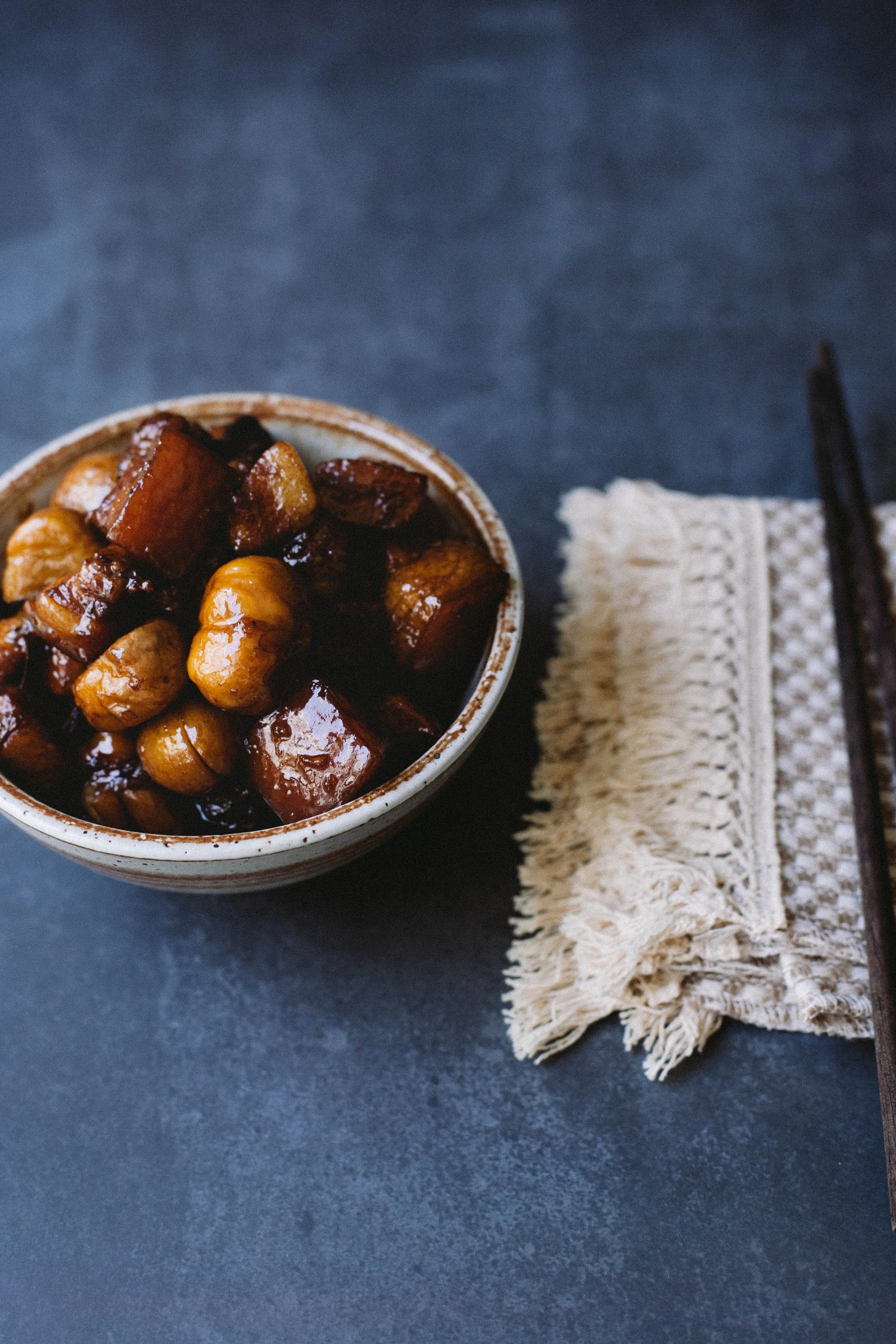
Dongbei Pork & Chestnut Stew
东北栗子肉炖
English: Dongbei Pork & Chestnut Stew
Chinese: 东北栗子肉炖
Pinyin: dongbei lizi rou dun
Literal: Dongbei chestnut pork stew
Note: This recipe originally appeared on The Mala Market.
The Northeast provinces of China are largely ignored when discussing the great cuisines of China. Sichuan, Guangdong and Shandong get all the limelight, whilst the frozen territories of the North are forgotten or assumed too simplistic and rustic. The cuisine has a reputation as nothing more than farmer’s food made with humble ingredients that are quite unfashionable in China today: grains like millet and sorghum, simple steamed buns, thick cuts of heavily-salted pork. And yet, on my visits up to the Northeast, I’ve found the food to be exactly what I need: dishes that fill my belly and warm my bones.
The food tastes almost Russian, which is not surprising – at various times over its history, parts of the Northeast were controlled by Russia. Borders in this region have been redrawn again and again over the years and as such food was exchanged, dishes tweaked and techniques borrowed from different countries. Pickling, stewing and curing became essential methods of preparation in Dongbei, as well as in Russia, Korea and Mongolia.
The residents of these regions did not historically have the luxury of abundance, like, say, Sichuan or Guangdong. Instead, their food traditions developed in the darkest depths of harsh winters. The three provinces that make up this region — Liaoning, Jilin and Heilongjiang — are brutally cold most of the year. Frozen fields and trees that fruit for only a few months of the year forced the people of Dongbei to innovate with their cuisine.
Chestnuts really make this dish; their subtle sweetness and crumbly texture add an unusual element to an otherwise simple stew. Chestnuts grow in abundance all over the Northeast of China, from the outskirts of Beijing right up to the mountains bordering Russia. They are widely used in pastries, desserts and savoury dishes. I love Dongbei’s liberal use of them, from the classic Braised Chicken with Chestnuts to simple Stir-Fried Chestnuts or even the slightly sweet Pork and Chestnut Dumplings. In this dish, they add a surprise - contrasting with the fatty, pork and rich broth adding a burst of subtle sweetness.
Serves 3 - 4
Ingredients
For the pork
1 pound pork belly (500g)
½ pound peeled chestnuts (about 25)
7 slices of ginger - unpeeled
6 scallions/spring onions
3 bay leaves
2 star anise
½ teaspoon whole Sichuan peppercorns
1-2 dried red chillies
1 ½ tablespoons rock candy or white sugar
1 tablespoon Shaoxing wine
2 tablespoons light soy sauce
1 tablespoon dark soy sauce
Method
Prepare the ingredients. Dice the pork belly into large rectangles about 1.5 inches in width. Slice the ginger with the skin on and cut the scallions into roughly 3-4 inch pieces.
Add the pork, 2 slices of ginger and 1 scallion to a saucepan and fill with cold water. Bring to the boil and skim off any foam that floats to the surface. This will take 2-3 minutes once boiled.
Drain the pork, rinse it and pat dry. Make sure it is dry otherwise the meat won’t brown in the pan.
In a large wok or saucepan add a tablespoon of oil and heat over a medium heat. Drop in the remaining ginger and scallions and fry until fragrant (about 1 minute).
Add the pork and fry, turning occasionally until the pieces are browned on each side.
Throw in the bay leaves, star anise, Sichuan peppercorns and chillies and fry for another minute then remove everything from the pan with a slotted spoon.
Keep the heat on but turn down to low. There should be fat in the pan from the pork but if not, add a drop more oil, then the rock candy (or sugar) and cook until dissolved into the oil like a caramel. Don’t stir the pan at this point otherwise the sugar can crystallise and feel grainy. Instead, tilt the whole pan to move the liquid sugar around. This can take anywhere from 2-5 minutes.
Watch the sugar carefully, you want it deeply brown and caramelised, but it can burn quickly. Once it’s thick and brown, turn up the heat to medium, add the pork and aromatics back into the pan and toss so the pork is nicely coated in the caramel.
Pour in the Shaoxing wine and let it bubble for ten seconds, then add the soy sauces, toss to mix everything, and then pour in enough boiling water to cover the meat.
Bring to the boil, then reduce to a simmer and cover for 50 minutes.
Add in the chestnuts, stir then cover again, simmering for another 30 minutes.
Take off the lid and keep simmering for a final 10 minutes or until the meat is tender. Taste for seasoning: add salt or a sprinkle of white sugar if you need, as well as reducing the sauce to your preferred thickness.
Serve with some steamed manto or hua juan buns as they do in Dongbei.



